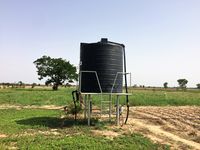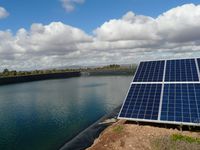Knowledge fuels change
For over a decade, Energypedia has shared free, reliable energy expertise with the world.
We’re now facing a serious funding gap.
Help keep this platform alive — your donation, big or small, truly matters!
Thank you for your support
Difference between revisions of "SPIS Toolbox - Reservoir"
***** (***** | *****) m |
***** (***** | *****) m (Protected "SPIS Toolbox - Reservoir" ([edit=sysop] (indefinite) [move=sysop] (indefinite))) |
(No difference)
| |
Revision as of 14:36, 18 July 2017

Introduction
Do want to know all about SPIS – Solar Powered Irrigation System : Please go to the newly launched standalone Solar Powered Irrigation Systems (SPIS) website (www.spis-toolbox.org) , featuring three SPIS toolbox:
- Toolbox for beginners,
- Toolbox for farmers (new SPIS Web based App – to calculate design of the pumps),
- the Toolbox for experts - the updated version - Version 6
and additional resources (Publication about SPIS).
The Toolbox on Solar Powered Irrigation Systems (SPIS) is designed to enable advisors, service providers and practitioners in the field of solar irrigation to provide broad hands-on guidance to end-users, policy-makers and financiers. Risks related to system efficiency, financial viability and the unsustainable use of water resources can thus be minimized. The Toolbox comprises informative modules supplemented with user-friendly software tools (calculations sheets, checklists, guidelines). read more
Modules and tools touch upon:
- assessing the water requirements,
- comparing the financial viability,
- determining farm profitability and payback of investment in SPIS,
- sustainably design and maintain a SPIS,
- highlight critical workmanship quality aspects,
- and many more.

style="width: 160px; background-color: rgb(111, 142, 43);" | ►Back to the Module Page
Reservoir
|
A reservoir can have several functions for an irrigation system: it can accumulate and store water pumped in over the day, it can provide pressure for the irrigation system to distribute the water to all corners of the field and, in small drip irrigation systems, it can be used to mix in soluble fertilizers. Since the output of solar pumps varies over the day as a result of irregular solar radiation, a reservoir can be useful to buffer the water amount available for irrigation. Open reservoirs are inexpensive and relatively easy to construct, but the big disadvantages are the high evaporation losses of water and easy accumulation of debris and sediments as well as algae growth. These effects can be significantly reduced by covering the tank, e.g. with a plastic foil. Evaporation and algae growth can be reduced when the solar panels are installed on floating mounting structures. |
|
|
Elevated water tanks: This is the classic configuration of a solar-powered irrigation system. The pumped water is stored in an elevated water tank and irrigation functions by gravity. The elevated tank serves as a battery where energy is stored in the form of water. The irrigation system pressure depends on the height of the water level in the storage tank. It also allows for pre-sunrise irrigation. Ready-to-use plastic tanks are available in different sizes, easy to install and do not corrode as metal or cements reservoirs do. In order to secure a safe system operation, a water level sensor should be installed in the water tank that switches off the pump to avoid overflow. If a submersible pump is installed in a well, a second water level sensor is required to protect the pump from dry running. Such sensors are often integrated into the motor pump by default. As water tanks usually store huge amounts of water, it is important that the foundation and support structure of the water tank meets the static requirements. |





















